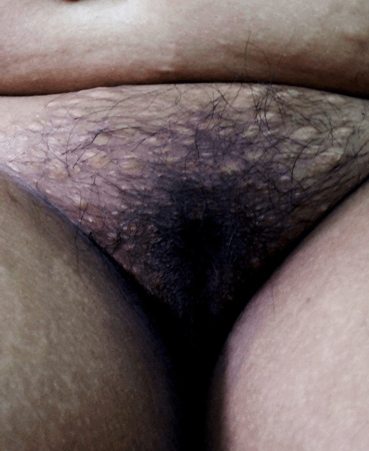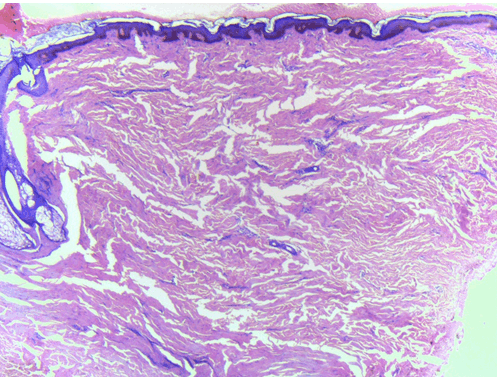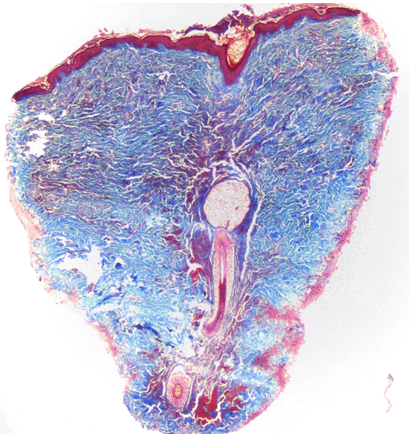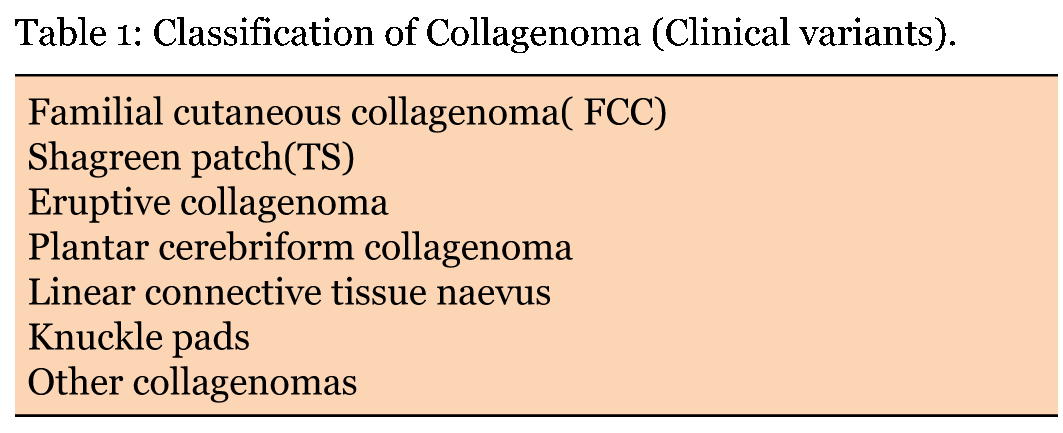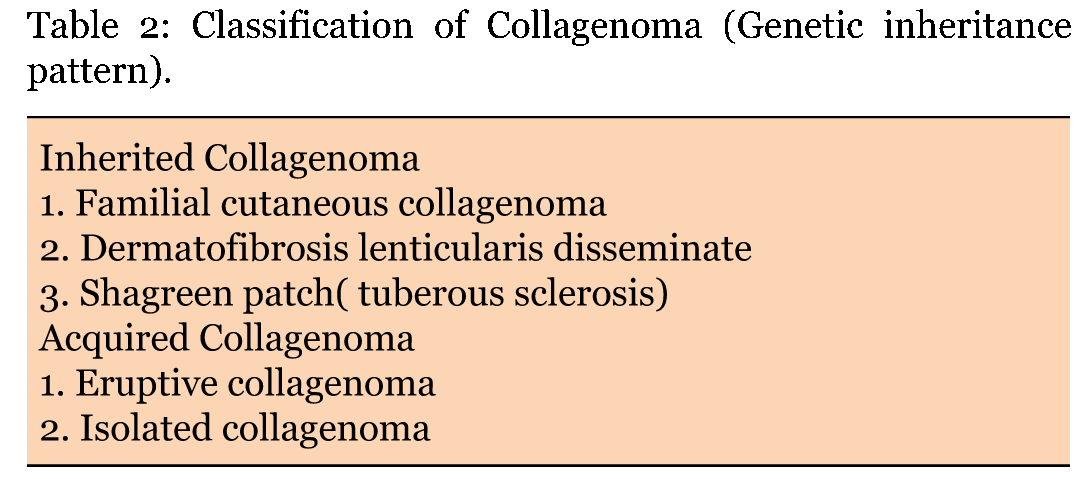  |

|
 |
|
Case Report
| ||||||
| Eruptive Collagenoma in a mongol girl: A rare association | ||||||
| Balwinder Kaur Brar1, Mahajan BB2, Nidhi Kamra3 | ||||||
|
1Assistant Professor, Department of Dermatology, Guru Gobind Singh Medical College and Hospital, Faridkot, Punjab, India.
2Professor and Head, Department of Dermatology, Guru Gobind Singh Medical College and Hospital, Faridkot, Punjab, India. 3PG Resident, Department of Dermatology, Guru Gobind Singh Medical College and Hospital, Faridkot, Punjab, India. | ||||||
| ||||||
|
[HTML Abstract]
[PDF Full Text]
[Print This Article]
[Similar article in Pumed] [Similar article in Google Scholar] 
|
| How to cite this article |
| Brar BK, Mahajan BB, Kamra N. Eruptive Collagenoma in a mongol girl: A rare association. Int J Case Rep Images 2015;6(7):427–430. |
|
Abstract
|
|
Introduction:
Eruptive collagenoma is a rare type of connective tissue naevi with predominant extra-cellular matrix component being collagen. Lesions are characterized by abrupt history of onset.
Case Report: An 18-year-old female with a clinical diagnosis of Down syndrome presented with abrupt onset of skin colored nodules on upper back and mons pubis. Lesions were asymptomatic. On examination multiple, firm, discrete, non-tender, flesh colored nodules were present on upper 2/3 of back and mons pubis. Histopathology aided with Masson's trichome stain confirmed the diagnosis of collagenoma. Conclusion: The association of collagenoma has been known with various systemic disorders but its alliance with Down syndrome and localization over mons pubis has still not been reported. | |
|
Keywords:
Eruptive collagenoma, Down syndrome, Mons pubis, Flesh colored modules
| |
|
Introduction
| ||||||
|
Connective tissue nevi are hamartomas characterized by an excess or deficit in the number of cells and their biosynthetic products including collagen, elastic fibers, and glycosaminoglycans [1]. Connective tissue nevi with predominantly collagen are referred to as Lipschutz type and with elastic component as Lewandowsky type. Multiple collagenomas are invariably present in several distinct syndromes like Buschke-Ollendorf syndrome, eruptive collagenoma, familial cutaneous collagenoma and tuberous sclerosis. Isolated cerebriform collagenoma of the palm and sole is a well-known entity and has been reported in association with Proteus syndrome. Eruptive collagenoma is a rare type of acquired collagenoma that was first reported in 1955 by Colomb [2] [3] [4] [5]. Herewith a report of eruptive collagenoma in Down syndrome is reported for its rarity and unusual localization. | ||||||
|
Case Report
| ||||||
|
An 18-year-old female with history of delayed milestones, low IQ, and typical Mongolian facies (Figure 1) (typical slant of forehead, and macroglossia) presented to our outpatient department with abrupt onset of asymptomatic skin colored nodules within a period of one month on upper back. The patient did not report any previous history of chicken pox/ trauma at the involved site. Her family history was unremarkable. A review of the various organ systems (cardiovascular, respiratory, gastrointestinal tract, central nervous system) was within normal limits. Examination revealed multiple, discrete, firm, non-tender, skin colored nodules measuring 0.5 to 2 cm in diameter with no scaling or exudation on the surface. The lesions were present predominantly on upper 2/3 of back and on thorough cutaneous examination similar lesions were present on the mons pubis, which as per patient developed 6 months back (Figure 2) and (Figure 3). We kept the differentials of eruptive xanthoma, steatocystoma multiplex and eruptive collagenoma. There was no evidence of hypopigmented macules on wood's lamp examination or skin lesions suggestive of tuberous sclerosis. There was no significant past medical or surgical history. The hematological and biochemical investigations including complete blood count, renal, liver function tests, urine analysis, lipid profile, electrocardiogram, abdominal ultrasound and chest roentgenogram were within normal limits. Skeletal survey did not demonstrate any evidence of osteopoikilosis. A skin biopsy obtained from the lesion on upper back and mons pubis showed focal acanthotic epidermis and significantly increased density of collagen bundles in the deep reticular dermis (Figure 4). Masson's trichrome stain confirmed the presence of dense collagen bundles with decreased elastic fibers (Figure 5). Thus a diagnosis of sporadic eruptive collagenoma with Down syndrome was made. | ||||||
| ||||||
| ||||||
| ||||||
| ||||||
| ||||||
|
Discussion
| ||||||
|
Collagenoma (collagen nevi) have been classified into distinct groups on the basis of clinical considerations (Table 1). Depending upon classification of the genetic inheritance pattern, collagenomas are classified as either inherited or sporadic (Table 2) with autosomal dominant inheritance common to all inherited subtypes. Eruptive collagenoma is characterized by abrupt development of multiple asymptomatic skin colored papules, nodules, plaques symmetrically on torso and proximal upper extremities but localization to mons pubis as in our case has not been reported. Collagenoma in eruptive type are smaller than those of familial cutaneous collagenoma. Collagenomas in FCC are also distributed symmetrically on trunk and proximal extremities, but are more numerous (in hundreds) and are also associated with various cardiac abnormalities like cardiomyopathy and conduction disorders [3] [6]. Shagreen patches (plaques of collagenoma) are present in tuberous sclerosis with other classic cutaneous findings like ash-leaf macules, facial angiofibromas, periungual fibromas (Koenen's tumor), gingival fibromas and fibrous plaque of forehead. Isolated collagenomas are sporadic and are localized most commonly on palm, sole and labium majus. Cerebriform plantar nevi are considered to be pathognomic of Proteus syndrome (a type of epidermal nevus syndrome) [4] [5] [7]. However, many authors have reported the presence of plantar collagenoma without any co-existent features of Proteus syndrome [8] isolated collagenoma on the scalp has been reported and can manifest as cutis verticis gyrata [9]. Collagenomas have also been reported in alliance with pseudohypoparathyroidism and hypogonadism [10] [11]. Though the pathogenesis of collagenomas is unknown, sporadic collagenomas may be related to trauma, since they appear most frequently in areas subject to friction, in Down syndrome too its pathogenesis is unclear. However, elastosis perforans serpiginosa is also well known as a complication of this syndrome, suggesting that Down syndrome may have various accompanying connective tissue disorders [12]. | ||||||
| ||||||
| ||||||
|
| ||||||
|
Conclusion
| ||||||
|
Collagenoma may be a marker of internal disease like tuberous sclerosis, Down syndrome, pseudohypoparathyroidism and it may be present in isolated or eruptive pattern as in our case. To the best of our knowledge, only eight case reports of eruptive collagenoma could be retrieved by searching on PUBMED/MEDLINE, with none being reported in Down syndrome with unique localization to mons pubis. | ||||||
|
Acknowledgements
| ||||||
|
Dr. Asha Kubba, Delhi Dermatology group. | ||||||
|
References
| ||||||
| ||||||
|
[HTML Abstract]
[PDF Full Text]
|
|
Author Contributions
Balwinder Kaur Brar – Substantial contributions to conception and design, Acquisition of data, Analysis and interpretation of data, Drafting the article, Revising it critically for important intellectual content, Final approval of the version to be published Mahajan B. B. – Analysis and interpretation of data, Revising it critically for important intellectual content, Final approval of the version to be published Nidhi Kamra – Analysis and interpretation of data, Revising it critically for important intellectual content, Final approval of the version to be published |
|
Guarantor of submission
The corresponding author is the guarantor of submission. |
|
Source of support
None |
|
Conflict of interest
Authors declare no conflict of interest. |
|
Copyright
© 2015 Balwinder Kaur Brar et al. This article is distributed under the terms of Creative Commons Attribution License which permits unrestricted use, distribution and reproduction in any medium provided the original author(s) and original publisher are properly credited. Please see the copyright policy on the journal website for more information. |
|
|





